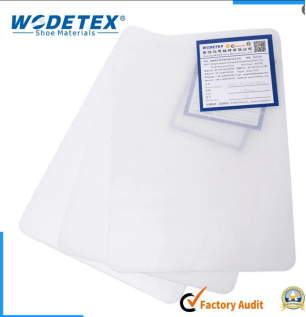In the high-stakes world of high-performance footwear manufacturing — where every gram of weight and every structural detail can make or break a product — one often overlooked yet essential material is quietly rising as the “hidden champion” of shoe bonding and structural integration: Hot Melt Film
While much attention is given to lightweight uppers, advanced midsoles, or cutting-edge cushioning technologies, hot melt film— a key enabler in modern footwear assembly — is stepping into the spotlight. Once merely a supporting adhesive tool on the production line, hot melt film is now evolving into a high-performance,multifunctional, and eco-friendly solution, becoming indispensable in the creation of next-generation footwear.

From Traditional Adhesives to Engineered Materials: The Evolution of Hot Melt Film
Traditionally, shoe bonding relied heavily on solvent-based adhesives or conventional hot melt adhesive strips. However, as shoe designs grow more complex — with diversified materials, stricter environmental standards, and increasing demands for structural stability — these conventional methods are showing their limitations.
Modern high-performance hot melt films have completely rewritten the rules.They are not ordinary adhesive materials, but rather precision-engineered polymer films created through advanced formulations and manufacturing techniques. Typically based on materials such as EVA (ethylene-vinyl acetate), TPU (thermoplastic polyurethane), polyamide (PA), or PO (polyolefin), these films are enhanced with tackifying resins and functional additives to achieve highly tailored bonding performance and physical properties.
Using a heat-press fusion process, hot melt films can bond seamlessly with various shoe materials — including mesh fabrics, leather, TPU films, and EVA foam — in just seconds. They offer high peel strength, excellent hydrolysis resistance, outstanding aging durability, and low VOC emissions, making them a far superior alternative to traditional adhesives in modern manufacturing.
þWhy Top Shoe Brands Are Choosing Hot Melt Film
The rapid adoption of hot melt film in footwear production is no coincidence. Its rise is driven by a suite of core advantages that align perfectly with today’s market demands.
① Ultimate Lightweighting & Structural Integration
In high-performance running and training shoes where “light as a feather” is the goal, reducing layers and adhesive weight is critical. Hot melt film is extremely thin (typically 0.05–0.3mm) and incredibly light,enabling direct multi-material lamination that eliminates unnecessary components. This helps reduce overall shoe weight while improving responsiveness and energy return.
② Exceptional Bonding Strength & Structural Stability
Compared to traditional solvent-based glues, hot melt film creates a uniform, continuous, and high-strength bond when thermally compressed. It performs exceptionally well in complex curved surfaces and multi-material combinations (e.g., mesh + EVA, PU + TPU), ensuring durable adhesion even under intense movement and stress — significantly extending the shoe’s lifespan and preventing delamination.
③ Eco-Friendly & Sustainable Advantages
With global environmental regulations tightening and consumer awareness of ESG (Environmental, Social, and Governance) values rising, hot melt film stands out as a green manufacturing solution. It is low in VOCs, solvent-free, and fast-curing,reducing environmental impact. Some premium-grade hot melt films are even made from bio-based or recycled polymers, helping brands meet circular economy and carbon neutrality goals.
④ Efficient Production & Cost Control
Hot melt film allows for rapid bonding (often completed within seconds)greatly improving production efficiency and simplifying manufacturing workflows. It reduces labor and energy costs while maintaining consistent material pricing and a mature supply chain — delivering an ideal balance of quality, performance, and affordability.
þVersatile Applications Across Footwear Segments
①Competitive Running Shoes
In top-tier racing shoes where minimal weight and maximum responsiveness are essential, hot melt film is widely used for bonding uppers to midsoles, and insoles to outsoles, ensuring structural integrity without adding extra mass.
②Training & Athletic Shoes
For high-impact activities involving multidirectional movement, hot melt film provides durable bonding in shoe body composites, tongue attachments, and collar linings, ensuring flexibility and strength during intense workouts.
③Outdoor & Hiking Footwear
In rugged environments, hot melt film offers excellent water resistance, cold-weather performance, and anti-aging properties, making it a key material for ensuring long-term durability in hiking boots and trail shoes.
④Fashion & Lifestyle Shoes
Even in style-driven sneakers, hot melt film enables seamless bonding, precision edging, and secure inner lining attachment, enhancing both aesthetics and functionality while meeting sustainability and efficiency goals.
þHot Melt Film: Redefining the “Intelligence of Bonding” in Footwear Manufacturing
The rise of hot melt film is a testament to the progress of material science and advanced manufacturing. Once a basic “support material,” it has evolved into a core enabler for structural integration, lightweight design, and green production — aligning perfectly with the three pillars of modern footwear: lighter, stronger, and more sustainable.When consumers put on a lightweight running shoe, a durable training sneaker, or a stylish eco-friendly lifestyle shoe, they may not realize that the seamless, durable bonds holding everything together — the hidden strength behind the design — come from that ultra-thin yet highly functional layer: hot melt film.Far more than just an adhesive, hot melt film has become a vital component in high-performance footwear manufacturing — and it will continue to drive the industry toward greater efficiency, sustainability, and intelligence in the years to come.As the saying goes:True innovation often lies in the most familiar connections.
Post time: Oct-16-2025
